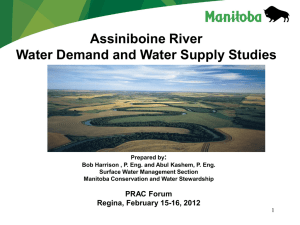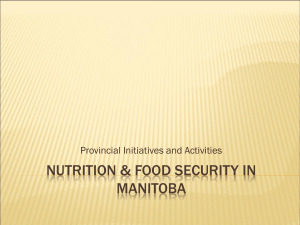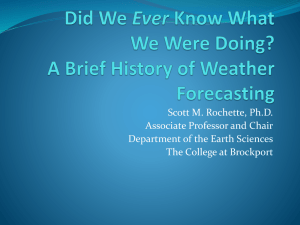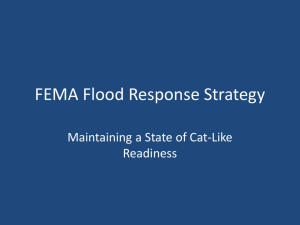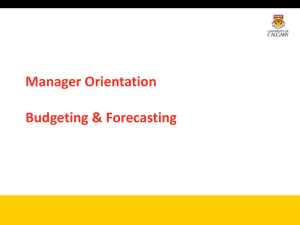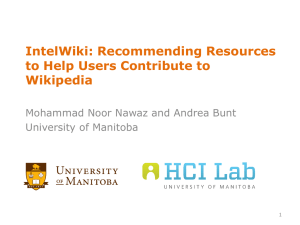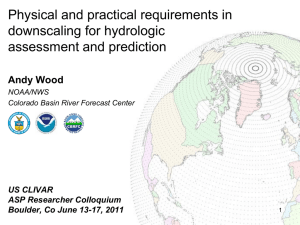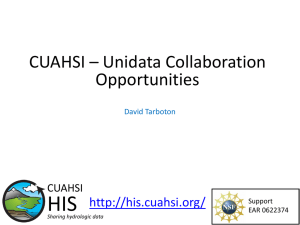PPWBPresentationF - Prairie Provinces Water Board
advertisement
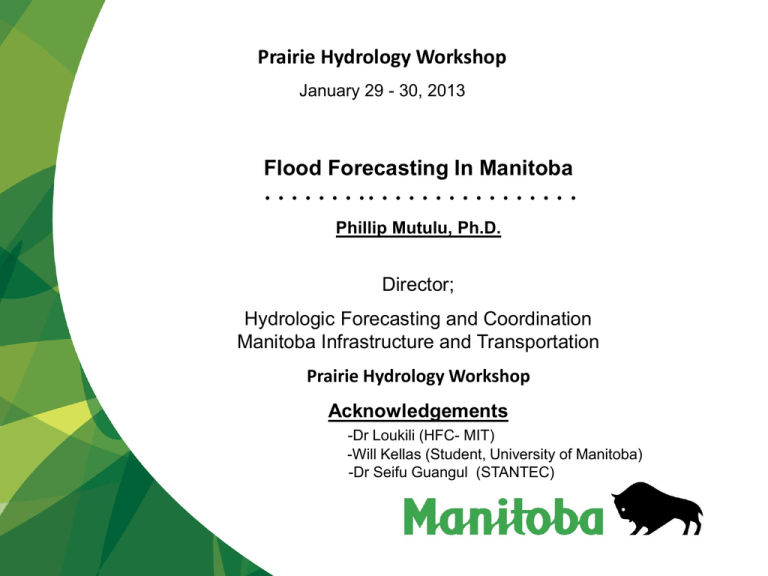
Prairie Hydrology Workshop January 29 - 30, 2013 Flood Forecasting In Manitoba • • • • • • • •• • • • • • • • • • • • • • • • Phillip Mutulu, Ph.D. Director; Hydrologic Forecasting and Coordination Manitoba Infrastructure and Transportation Prairie Hydrology Workshop Acknowledgements -Dr Loukili (HFC- MIT) -Will Kellas (Student, University of Manitoba) -Dr Seifu Guangul (STANTEC) Overview of Presentation Hydrologic Forecast Centre Main Responsibilities Current Forecasting Methodologies Current Efforts, Developments Challenges Future Directions Hydrologic Forecast Centre Products Precipitation Maps Moisture Maps Snow Depth Maps Forecast Hydrographs of River Flows/ Levels, Lake Levels Flood Reports Weekly Flow Reports Weekly Lake Level Wind Alerts on Major Lakes Land subdivision review information/ flood protection levels etc. Current Flood Analysis and Modelling Methodologies (1) Manitoba Antecedent Precipitation Index MANAPI - Unit Graph + Muskingum routing for major rivers - Unit Graph + Linear Storage routing (simple numerical schemes, and Runge Kutta 4th order scheme - Natural Resources Soil Conservation (NRSCN) for excess rain computation (2) Analog approach (3) Regression Based Methodologies Simplified Schematic of River Flow Forecasting Model (Event Based Approach) API CURVE Runoff Unit Graph (Snowmelt or Rain) Winter Precipitation Sub-Basin Moisture Index Spring to Freeze-up Precipitation River Watershed History of Hydrologic Model Development in Manitoba •Model developed started in early seventies, leading to Manitoba Antecedent Precipitation Index (MANAPI ) •Since the MANAPI is used for routine flood forecasting) • Model Evaluation: 1985 MANITOBA RIVER FORECAST DEVELOPMENT evaluation project; by Canada – Manitoba Flood Damage Reduction Program Agreement Respecting Flood Forecasting. Evaluated in 1985 against:HSPF; SSARR, and SLURP •Recommended that:Lumped index models such as MANAPI or improvement thereof continue to be used for river forecasting in Southern Manitoba until more accurate and practical simulation models become available. •2008-2012; Improvement: From Fortran Dos Compiled routing to Excel Macro Based approach; convenient in data transfers, storage and graphics. •Current efforts; MANAPI improvement (In House), HEC-HMS (In House), MIKE-SHE (Consultants), WATFLOOD (Manitoba Hydro); Modelling Limitations •Accounting explicitly for :depression storages/ Contributing area soil moisture distribution land use and cover physics of snowmelt frozen Soils two dimensional overbank flows runoff from rainstorms ice related flooding Hysteresis effects like in 2011 Accurate Forecasts are highly dependent on forecasts from other neighbouring provinces and the US 390,000 km2 160,000 km 2 285,000 km2 Hydrologic Forecast Centre Regulatory and Operational Services, Manitoba Water Stewardship Red Deer Lake Levels - April 23, 2011 Operational Forecast 865 Levels in Feet 864 863 862 861 860 859 Lake Levels - Lower Decile Lake Levels - Median Lake Levels - Upper Decile 1972 Spring Peak Level 1985 Spring Peak Level 2007 Spring Peak Level Observed Lake Level Efforts in Modelling/ Tool Development • Improved mass balance lake inflow-outflow modelling • Revision and delinking of pulse response functions (unit graphs) for snowmelt and rain generated runoffs • Automation and improvement of existing and new methods of data analysis and modelling; exploring eventbased Vs continuous simulation models. • Hydrologic modelling; Assiniboine R. including Qu’Appelle Basin • 2- Hydrodynamic Modelling for the Assiniboine and the Red R. Basins Assiniboine Qu’ Appelle River Basin Modelling: (semi-continuous) •Previous model, based on SSARR (1975) – PPWB/WSC study •Current inhouse study based on HEC-HMS, Soil Moisture Accounting approach for Months of May to September to account for rainfall-runoff events •Calibration & Validation Phase I completed – needs improvements •Difficult in implementation of the snow-melt routine •Challenges in accounting for regulated flows-need to work with Saskatchewan Water Authority C2 Area = 560 km 2 Challenge in Kc Determination. What are your experiences ? Snowmelt 2005 _ Calibration Challenges in continuous hydrologic simulation, especially during transition from snow driven events to rainfall driven events Mean Flow Simulated = 14.0 m3/s Observed = 12.0 m3/s Example:- Problem with Continuous Simulation Some questions to ponder ! Where do we go from here ? • is more complex hydrologic models the solution ? • is there a single model that works all the time ? • what about data adequacy, data bases and metadata issues • what are the priority areas of research and development ? E.g. Continuous Simulation Models: Hydrological Processes in MIKE – SHE Challenge of multiple sources of data/ databases Numerical Weather Forecast Satellite Weather Radar Weather Stations Upstream River flow forecasts Special Aircraft Soil Moisture Flood Forecasting Centre Snow Depth Automatic River Gauges Water Level & Flow Rate COMPLEX INFRASTRUCTURE MANITOBA HYDROLOGIC FORECAST CENTRE INTO THE FUTURE !! Manitoba Flood Forecasting Platform/ Decision Support System Hydrometric Data Acquisition system Radar/ Satellite Data Pre-processing Calibration Flood Forecast Models Data Base Management System GIS Meteo Forecasts/ or Prepared scenarios Information Review Process Post-processing Flood maps/ Reports / Web publish Forecast Products Consumer Concluding Remarks/ Future Direction • Automatic ingestion of ensemble weather forecasts and/ or stochastic generated info • Real-Timer data assimilation e.g. soil moisture and precipitation from air-based and other telemetry platforms • Continue model development inter-comparison and testing • Expand and ingest information from Community Collaborative Rain and Snow program CoCoRAHS (New Initiative) • Research and development of soil moisture and ice-jam related flooding modelling • 2-D hydrodynamic flood routing • Flood Forecasting Platform System (Dedicated and delinked from Managed Environment) Soil Moisture Conditions at Freeze-up time in 2010 and 2012 Snow water equivalent in January 24, 2013 and January 2011 End of Presentation Thank You


